9 Steps to Content Marketing Excellence for Small Businesses

Today, the business world’s landscape changes drastically, creating space for small businesses to emerge and challenging them to withstand the competition and reach their target audience.
Different marketing approaches can be costly and offer very limited results in accordance with the agency’s capabilities. Thus, small businesses choose content marketing. It is one of the best choices to establish a strong online presence, engage customers, and build a lasting connection.
Content marketing can seriously improve operations in businesses of all sizes, but it is of utmost significance for small enterprises. It can create and share a lot of valuable, helpful, and consistent content, which helps to retain the audience's attention and generate leads.
In this article, we delve into content marketing for small business in greater detail. We will unveil nine practical tips for small businesses to survive in the digital era and enhance their operations with content marketing. But before we dive deeper into how to use content marketing for small business, let’s start with the definition.
Content marketing: definition
At its essence, content marketing is a strategic marketing approach. It is centered around valuable, relevant, and consistent content. Accordingly, all publications aim to attract and retain a clearly defined audience. Compared to other strategies, content marketing doesn’t emphasize promotions and, instead, provides help, information, entertainment, and solutions that genuinely resonate with the audience's needs and interests.
As mentioned, content marketing provides a user-centric approach relying on content. Speaking of the latter, there are numerous types of content today. Accordingly, this strategy works with the following types of content:
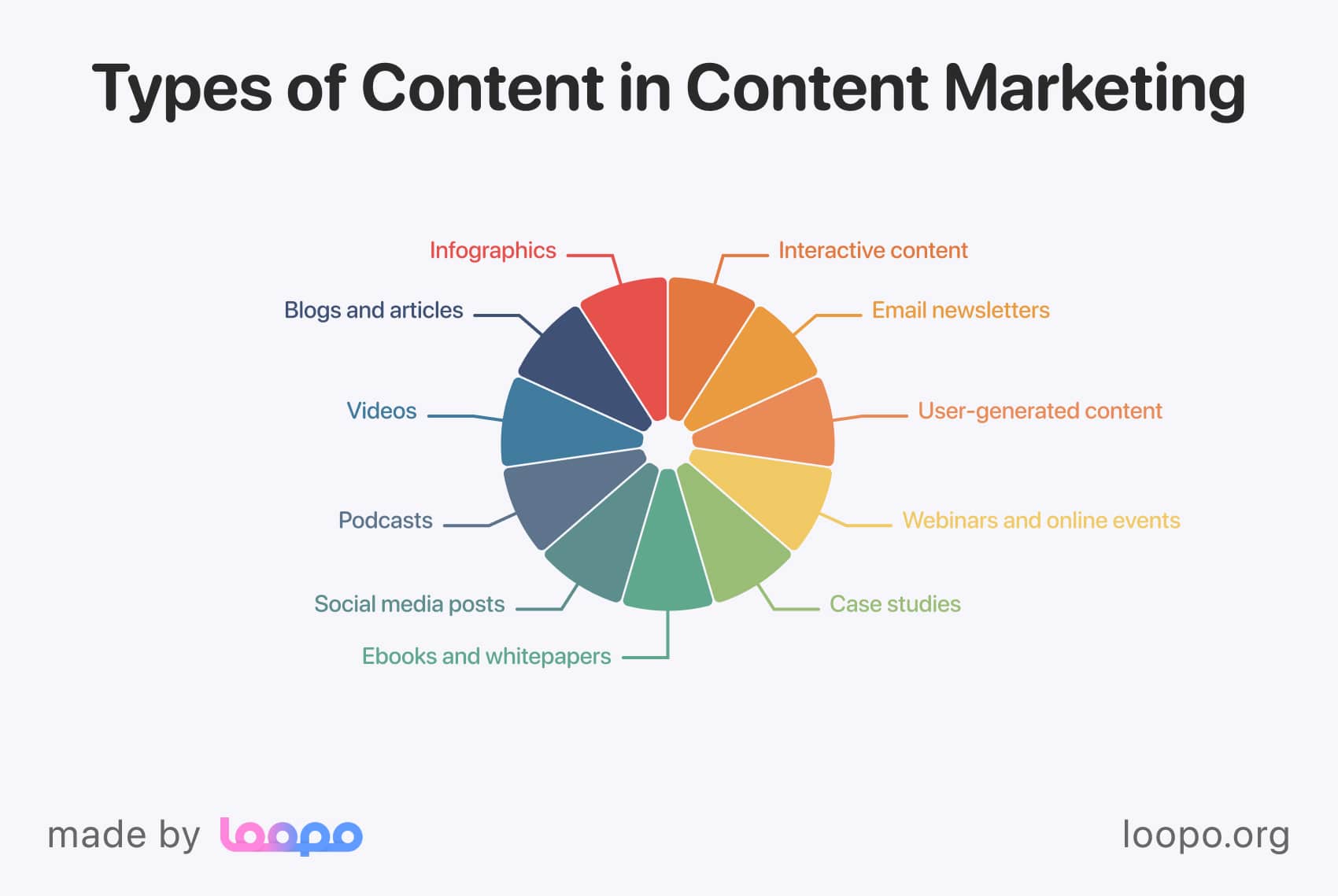
- Blogs and articles. Written content has always been one of the most popular and foundational types of content marketing. Articles and a well-developed blog allow companies to share knowledge, guide users and showcase their expertise. Articles are also extremely effective if you are planning to make use of search engine optimization (SEO).
- Infographics. This type stands for appealing data, processes, and information representations. The main task of infographics is to deliver complex information and make it simple and memorable. Hence, it utilizes visuals, making them shareable and easy to understand. Infographics are excellent for simplifying statistics, comparisons, and multi-step processes.
- Videos. Video content has become increasingly prevalent in content marketing, and it has many practical implementations. For instance, companies can make product demonstrations, explainer videos, and even customer feedback. videos are highly engaging and can communicate a brand's message effectively.
- Podcasts. Unlike videos, podcasts are audio-based content pieces. They offer an opportunity to dive deep into topics, conduct interviews, and establish thought leadership within a niche.
- Social media posts. Being the most widely popular content, social media platforms are an extremely powerful way to project a company’s values and create a name for a content marketing agency for small business. They allow you to share lots of types of content simultaneously. For instance, the content may include videos, images, text, and infographics. Social media posts help businesses interact with their audience, build a community, and promote their content organically or through paid advertising.
- Ebooks and whitepapers. Ebooks and whitepapers are in-depth, long-form pieces of content that provide valuable insights, statistical research, findings, or comprehensive solutions to complex problems. They are often used as lead magnets. To get access to one, users often need to share email addresses which are later used to share even more information.
- Case studies. These are created to demonstrate the business’ expertise. Case studies showcase real-life examples of how the business delivered a product or service, how it solved a problem or brought significant benefits to a customer.
- Webinars and online events. Webinars and virtual events allow businesses to host live presentations, workshops, or panel discussions. These interactive sessions provide value to attendees while showcasing the expertise of the host organization.
- User-generated content. UGC is everything the users can generate. It often includes testimonials, social media posts, and reviews. Hence, UGC’s presence adds more authenticity to a brand's messaging.
- Email newsletters. They are created to keep subscribers informed. For instance, such emails inform about the latest updates, blog posts, promotions, and industry news. They help maintain a connection with the audience and cultivate recurring website visits.
- Interactive content. This type is less popular as its appropriateness depends on the niche. Normally, it includes quizzes, polls, surveys, and interactive infographics. All these aspects can greatly encourage people, allowing them to participate and share their results.
Benefits of content marketing for small business
Once you understand what content marketing is, its benefits become clearer. Naturally, it has a lot to offer. To make it easier to understand, see, and memorize, let’s draw a clear line where on the one side, we’ll talk about the founding pillars of content marketing, and on the other, we’ll cover their impact.
The pillars of content marketing
As mentioned, content marketing is built on pillars that form its backbone. These pillars can also be addressed as benefits of content marketing for your small business. They directly affect how the client is treated and the advantages they receive. So, the benefits are as follows.
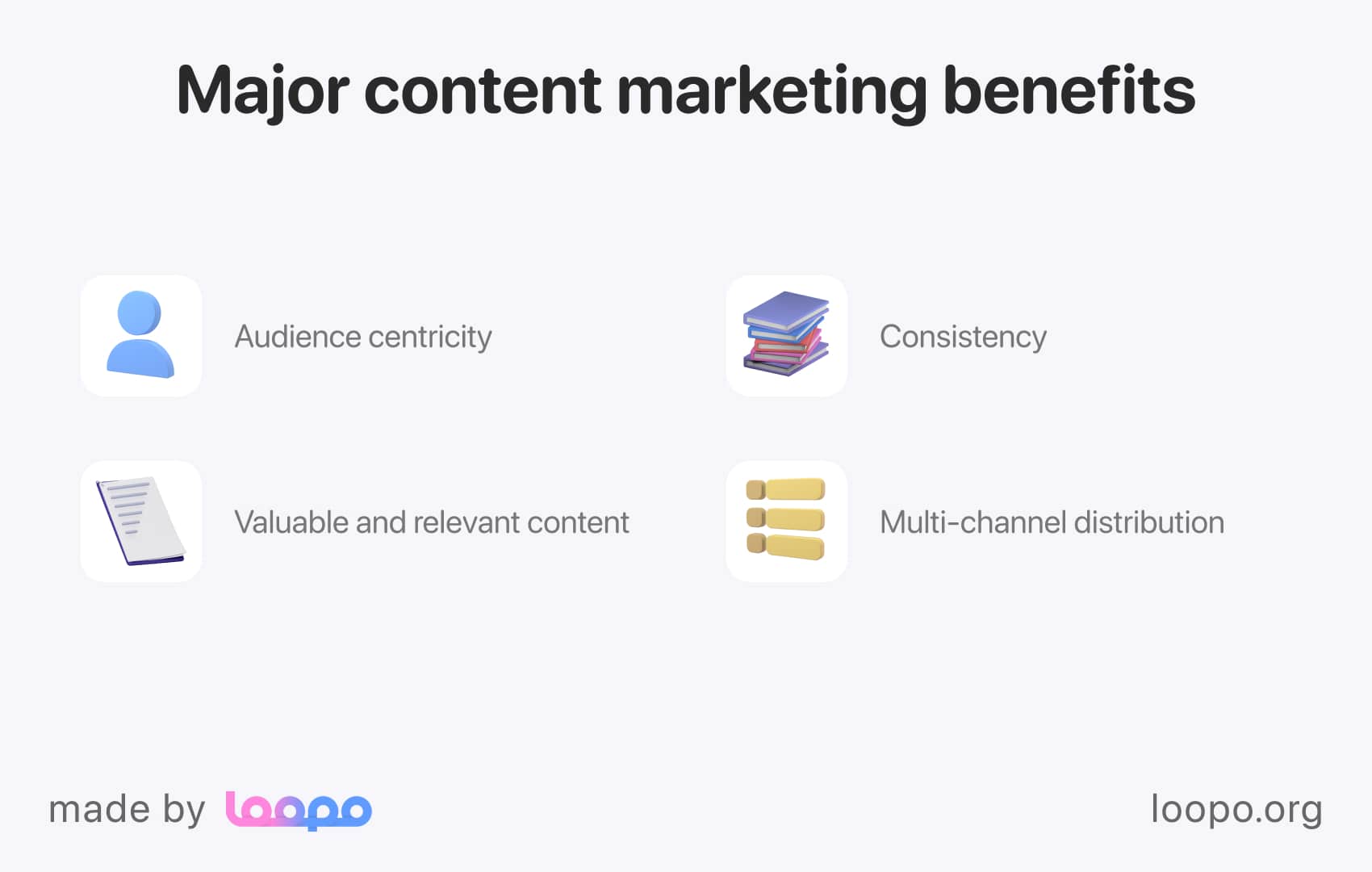
Audience-centricity. Through numerous content types, content marketing aims to understand the audience, learn about their pain points and find out their aspirations. So, content marketing produces content that is relevant to specific user needs, forming a bond between them and a business.
Content’s value and relevance. Because of audience-centricity, content marketing has to produce valuable and relevant content. Hence, it thrives on providing value to the audience. The actual content must be informative, entertaining, educational, or all in one. Providing it, the content marketing strategy allows businesses to engage the audience and make a return.
Consistency. When the business regularly appears online and shares tips, information, and content, it gains credibility and trust. Moreover, consistency speaks for itself, as it’s clear to all users that the marketing team works, posts something, and engages with the audience on a regular basis.
Multi-channel distribution. With the myriad of content types, multi-channel distribution is extremely important, and fortunately, content marketing can do it. Normally, different content types are inherent to different channels. For instance, articles reside in blog sections or on social media platforms. Posts, announcements, news, and videos are typically on social media platforms. With this idea, content marketing can effectively aim at different channels simultaneously, expanding its reach and maximizing the impact of the content.
The impact of content marketing
With a clear understanding of the benefits of content marketing, let’s discuss the impact they can have. In this matter, even small limited-budget businesses can yield great results from it.
First of all, thanks to content marketing, the level of brand awareness is undeniably high. Delivering user-centric, valuable, and consistent content helps businesses occupy the dominating position in their niche, leading to increased brand visibility and recognition.
Secondly, all those pressure points we discussed earlier not only increase brand awareness. They boost customer engagement, which is a key factor for businesses to grow and prosper. So, interesting to read, helpful, and engaging content brings a lot. It sparks conversations, generates opinions, inspires to start something, and simply fosters a vibrant community around the brand.
Apart from pure engagement and interest, content marketing is capable of generating leads and conversions. Valuable content attracts potential customers, nurturing them through the buyer's journey and increasing the likelihood of converting them into paying customers.
It is also worth noting that a powerful content marketing campaign can do a great job of boosting search engine rankings. Simply put, superior quality content can be additionally optimized for search engines. In turn, it can boost organic traffic, visibility, and ranking, attracting even more leads.
Top 9 tips for managing content marketing
In a small business, content marketing management is not black and white, meaning that it’s neither easy nor difficult. Instead, it would be wise to see it as a diverse tool. Accordingly, this diversity creates room for experiments, tactics, and strategies.
In this section, we will take a closer look at tips that can help you figure out how to use content marketing for small business, and manage content for it. They vary in ideas and aim to improve different aspects of the entire strategy. However, each of them possesses valuable knowledge and will be helpful whether you’re a seasoned entrepreneur or a beginner.
Tip 1: Start from strategy
Always. A proper strategy is a key to success as it enlists numerous factors you wouldn’t want to neglect. A good strategy tells about your audience and contains a plan, goals, and pain points of your business. For clarity, let’s put the lion’s share of parts normal content marketing strategies for small business ought to include.
| Component | Description |
| Goals and objectives
| Defines the main objectives of the content marketing efforts in alignment with the overall business goals.
|
| Target audience and buyer personas
| This section focuses on creating detailed buyer personas and identifying the target audience. It allows you to learn their interests, demographics, problems, and behavior patterns.
|
| Competitor analysis
| In this section, you document and collect information about the present competition in the market. Research and analyze competitors' content marketing strategies to identify opportunities and learn from successes and failures.
|
| Content types and formats
| This part of the strategy determines the types of content and formats that best resonate with the target audience and suit the business goals.
|
| Content distribution channels
| This section helps to choose platforms and channels for content distribution. They can be websites, blogs, social media, email newsletters, guest posting, and content partnerships.
|
| Content calendar and schedule
| At this point, you need to create a content calendar to plan and organize content creation and distribution. This approach helps to ensure consistency and timely publishing.
|
| Branding and tone
| Here, you figure out what tone of voice your brand uses and what style to adhere to across all content to reinforce brand identity and messaging.
|
| Metrics and analytics
| In this part, you need to define the most crucial metrics to track. For instance, you can emphasize analyzing website traffic, engagement, conversions, and ROI.
|
| Budget and resource allocation
| This part of the strategy outlines all financial aspects of the business. It helps to allocate budget and resources (time, manpower) for content creation, distribution, and promotion.
|
Tip 2: Tell stories, not facts
Storytelling is one of the key aspects that can turn simply good content into superior one. However, it’s vital to keep the balance between stories and facts. For instance, pure facts can feel tedious, whereas stories not backed with facts may feel not serious enough, lacking credibility.
Nevertheless, storytelling is an extremely powerful approach in content marketing strategy for small business. It brings several benefits to both you, a brand owner, and your users or clients.
- Emotional connection. Stories tend to evoke emotions, which are powerful drivers of human behavior. When your team crafts strong narratives and delivers value, you can tap into your audience's feelings and understand them more.
- Memorable content. Compared to facts, good stories are remembered. People are more likely to recall the info they read and share a word about it. Hence, this memorability aspect can help you raise brand recognition and generate more word-of-mouth referrals.
- Differentiation. Storytelling can help your business stand out in a world of repetitive information. It adds a personal touch to stories which can set you apart from competitors who might be focusing solely on presenting facts and figures.
- Additional explanation mean. Some products or services might be difficult to explain with just facts and statistics. With the help of stories, you can visualize abstract and comprehensive ideas and make them more relevant to your audience.
Tip 3: Organize your content production flow
This tip refers to the process of streamlining and optimizing the content creation process to ensure efficiency, consistency, and high-quality output. The proper organization always brings numerous advantages. It can help your team stay on track, meet deadlines, and produce content that aligns with your overall marketing goals.
In this matter, today’s digital world can be of utmost help as there are numerous tools that will simplify this step for you. Let’s overview this tip on the example of Loopo.
So, as mentioned, the right tool for production flow must have the following:
- Content planning capabilities. Loopo has a calendar where you can schedule publications. You can add tags to publications, allowing Loopo to sort them for you and simply differentiate them at a glance.

- Collaboration capabilities. Loopo’s built-in editor allows you not only to plan but edit and create publications. With a range of text formatting options, you can write anything without leaving the platform. Moreover, you can create a workspace dedicated to your project, where you can collaborate with your team, share feedback, text each other, and track progress.
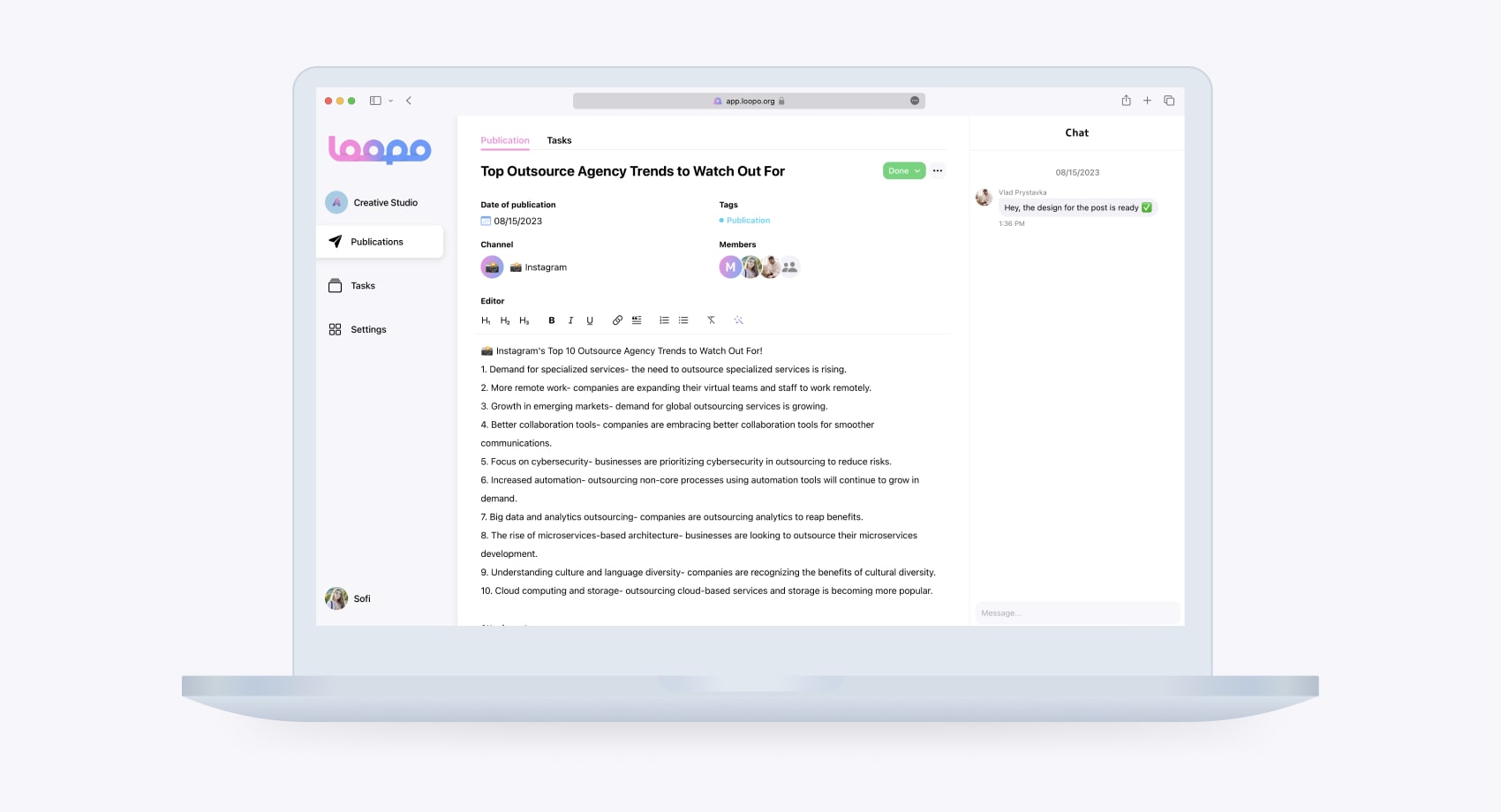
- File sharing. Each work process involves lots of files, folders, images, etc. Hence, file-sharing functionality is vital and you should look for tools where it is presented. In Loopo, you can attach many different file formats to each publication you create. Paired with online collaboration, it is extremely helpful for teams to manage everything.

- Adaptability and flexibility. While organization is vital, also be open to adapting and adjusting your content production flow based on feedback and changing market conditions. Loopo provides such flexibility. For example, you can freely move the publications on the calendar, submit different publication versions, extend deadlines, and more.
After all, Loopo grows and prospers. It caters to teams with a simultaneously simple and powerful solution to handle their content flow. As the digital landscape grows, there are more features yet to come. Give it a try yourself, and sign up!
Tip 4: Be experimental and avoid creating generic content
This tip is all about generating numerous small business marketing ideas to keep up with the ever-changing market. It never stays the same as trends change and tendencies vary. Hence, to create an effective content marketing strategy, you need to focus on creativity, innovation, and uniqueness throughout your publications. From one marketing geeks to others, here are a few pieces of advice.
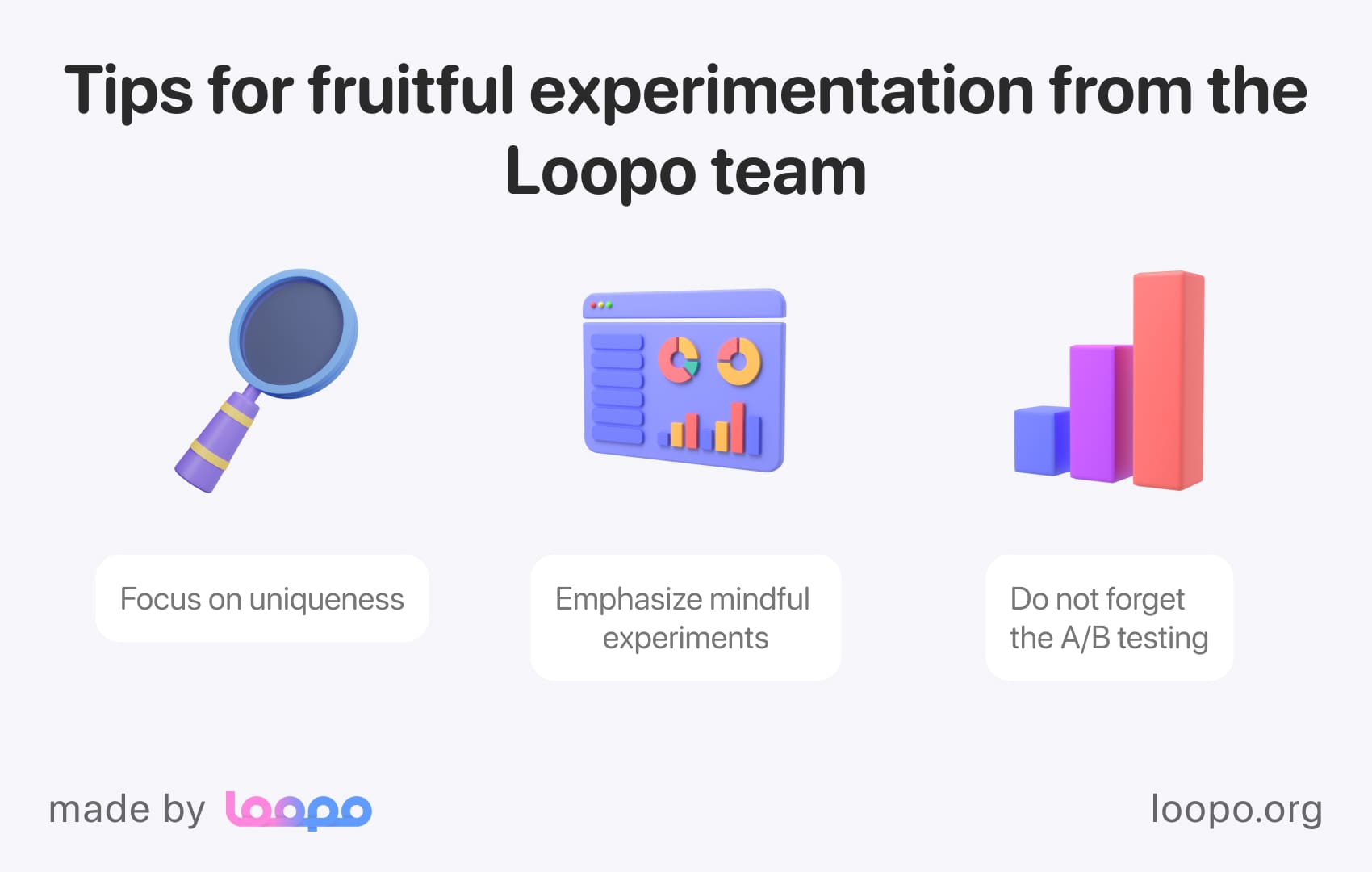
First of all, focus on uniqueness. Generic content often lacks a distinctive voice or perspective. By being experimental and unique, you can present your brand, products, or services in a fresh and captivating way that differentiates you from competitors.
Secondly, always try mindful experimenting, as they encourage creativity. You can always try new formats and techniques, but make sure to do it with a solid understanding of what you are doing. Think of how it can affect the audience and how it will react. The audience always notices changes. Hence, you can stimulate discussions, ask what they think and gradually improve your agenda.
Lastly, do not forget about A/B testing. Any kind of experiment must go hand in hand with A/B testing. It provides room to test different scenarios and variations of your content. Then, you will simply need to compare which elements perform better with your audience. This data-driven approach helps you refine your content strategy and focus on producing the most effective content.
Tip 5: Diversify and repurpose content
Usually, there’s no need to create totally different agenda for different channels. Instead, all channels you use must feel as if they belong to one ecosystem. Hence, instead of creating something totally different for all channels you use, one of the coolest marketing ideas for small businesses is to try diversifying and repurposing content.
By diversifying your content formats, you can appeal to a broader range of people. Some value in-depth blog posts, and others better comprehend when they hear information through videos or podcasts. Different audience segments need different content, and you need to account for that.
Also, note that different content formats perform better on different platforms. For instance, on social media, visual content like infographics and videos are dominant and perform well.
Repurposing content can remind you of copywriting, as it involves taking existing material and presenting it in a different way. For example, you could turn a blog post into a podcast episode, create an infographic based on research findings, or compile a series of related articles into an e-book. This way, you can give new life to older content and reach audiences who might have missed it initially.
Moreover, it is highly beneficial for search engine optimization. When you republish or update an existing piece of content, search engines may recognize it as fresh content, potentially improving its search ranking. Additionally, having content in multiple formats can increase your chances of ranking for different types of search queries.
Tip 6: Promote your content
Generally speaking, there are myriad ways to promote your content online. In this matter, you can turn to different marketing strategies that emphasize different approaches.
On the one hand, you can promote your content with social media marketing. This means you will need to leverage social media postings, engage with the audience and stay active.
On the other hand, you can do email marketing if it’s a dominant channel for your business. With its help, you can create different newsletters and digests to inform your users about the latest news, postings, etc.
Alternatively, you can use influencer marketing and start promoting your brand with media people. Or you can try doing it yourself with content distribution platforms like YouTube or Medium.
Lastly, you can turn to paid advertising and share your content with it. Luckily, the absolute majority of platforms support ads. For instance, you can try Instagram, LinkedIn, Twitter, and YouTube or set up advertisements with Google Ads, which will appear in searches and on other websites.
You may also like: How Marketing Agencies Make Money: Most Profitable Pricing Models for Agencies
Tip 7: Communicate with the audience
Proper communication is key to creating a natural and lasting dialogue with your users. Effective communication can provide you with curious insights and learn true opinions about your product, service, or business in general.
Note that communication is very diverse. To keep it on a certain level or standard, make sure you connect with your audience through comments, messages, and social media interactions. Always respond to their questions, listen to feedback, and address any concerns timely.
If you want to bring this aspect to another level, show that you not only communicate but also listen. Regularly ask for feedback, compose different kinds of surveys, and show that they matter.
Another impression-changing thing you can do is to organize live Q&A sessions, webinars, or streams. These events provide an extremely high level of credibility to your business. There, you can address specific queries, showcase your expertise and even seek talents.
Lastly, when communicating, the feedback can be too big. Hence, learn about segmentation. Categorize your audience based on their behaviors, preferences, or feedback they leave. Then, adapt your agenda to each particular segment to provide very relevant content, help, or assistance that meets people’s specific needs and interests.
Tip 8: Use omnichannel marketing - build ecosystem
Omnichannel marketing advocates creating a seamless and integrated experience for your audience across all channels, platforms, and touchpoints. In other words, it can be called an ecosystem, where your content is consistent and complements its other instances.
It may seem difficult to understand, yet it’s quite simple if you follow a few essential tips.
- Establish a consistent design. All elements of your branding must feel consistent and complement each other. These elements include color schemes, logos, tone of voice, imagery, etc.
- Try cross-channel promotions. Once you set up several channels, it would be wise to cross-promote them. This way, you can deliver different formats to your audience, grow the number of followers and strongly settle in their feed. For example, you can share your blog posts on social media posts, send new case studies via email newsletters, and so on.
- Optimize everything for mobile devices. In the US, nearly 70% of the total digital media time is spent on smartphones. So, optimizing all your content for a mobile-friendly experience is crucial for omnichannel success.
- Enhance the user experience. When it comes to the website, blog, and other web pages, you should do your best to provide users with a seamless experience, fast loading, and excellent performance. When you make it easy for visitors to find what they need, navigate and browse, they passively appreciate it and are more likely to return.
- Measure and optimization the performance. There are numerous analytics tools and metrics you can utilize to gain valuable insights into your campaign’s performance. Make sure you identify which channels are driving the most engagement and conversions. Learn what exactly brings such results and see how you can implement them on other channels.
Tip 9: Analyze everything
Now, to the last concluding tip, which can help you improve everything we covered in previous tips. Analyzing the performance of your content marketing efforts is priceless today. It can reveal tons of useful information, allowing you to make data-driven decisions, plan future campaigns, and expand your reach.
So, how does this all-embracing analysis work, and how can it help your content marketing strategy?
First of all, its approaches allow you to collect audience insights. When you analyze the performance, you can reveal tendencies, users’ behavior patterns, and interests. Such information can include many data, and some of it includes:
- Users’ average age and gender;
- Channels they prefer the most;
- Preferable devices to view your content;
- Times they are most active.
Secondly, analysis techniques can help figure out the performance of each piece of content you create. Track metrics such as page views, time spent on the page, bounce rates, and social shares. This analysis will help you identify what types of content resonate best with your audience and which topics are the most engaging
Alternatively, if your content marketing goals are centered around lead generation or sales, you can track conversions. Measure how many visitors take the desired action after consuming your content.
Performance-wise, another worthy aspect to analyze is SEO. In this world, you need to keep track of keyword rankings, organic traffic, and backlinks to understand how well your content ranks and is discovered by your target audience.
Then, there are several channel-specific techniques worth noting. For instance, if you aim to grow on social media, you’ll definitely need to keep track of corresponding metrics such as likes, shares, comments, and click-through rates.
In the email marketing realm, marketers mainly focus on measuring the open rates, click-through rates, and conversion rates of your email campaigns. Then, simply figure out which types of emails and content resonate most with subscribers.
How to create a small business content marketing strategy
The actual process of creating a content marketing strategy for a small business is a set of all tips we mentioned in this article. So, to sum everything up, here is the logical process of how to build a content marketing strategy.
| Practical steps to start a content marketing strategy | |
| Know your audience and choose the right channels | 1. Understand your target audience's preferences and behavior. |
| 2. Identify the platforms where your audience is most active. | |
| 3. Tailor your content distribution strategy accordingly. | |
| | |
| Leverage social media | 1. Create profiles on relevant social media platforms. |
| 2. Share content regularly and maintain a consistent posting schedule. | |
| 3. Communicate with your audience using comments or threads. | |
| 4. Consider social media advertising to reach a broader audience. | |
| | |
| Email marketing | 1. Compose an email list by offering e-books, free courses, or access to additional content in exchange. |
| 2. Segment your email list for targeted content delivery. | |
| 3. Avoid spammy tactics and focus on providing value in emails. | |
| | |
| Collaborate with influencers, companies, media | 1. Identify potential partners in your niche with a significant following, similar philosophy, and audience. |
| 2. Reach out for potential collaborations and sponsored content. | |
|
3. Leverage partnerships to reach new audiences and attract new people. | |
| | |
| Repurpose and refresh content |
1. Repurpose content into different formats for wider reach. |
| 2. Refresh evergreen content to maintain relevance and value. | |
| | |
| Engage with online communities | 1. Participate in industry-related forums and platforms. |
| 2. Share expertise and answer questions to build trust. | |
| 3. Avoid excessive self-promotion; focus on providing value. | |
| | |
| Monitor and measure performance |
1. Use analytics tools to track website traffic and engagement. |
| 2. Measure email open rates and conversion metrics. | |
| 3. Analyze data to refine your content strategy effectively. | |
After all, these steps may change a lot depending on how you are planning to operate your business. However, some of them can form a solid foundation for your content marketing and help you start attracting first visitors.
Free content marketing tools for small business
Apparently, another benefit of living in a digital era is the presence of numerous tools that are available completely for free. You can easily find tools that can help you with content marketing in various aspects. Let’s list a few examples divided into categories.
Loopo's impact on your content marketing
As mentioned, content marketing requires solid management skills as you normally would want to use several channels, conduct research, analyze performance, make SEO audits, etc. Fortunately, today’s digital world has a lot to offer in terms of management, planning, and delegating such complex processes.
In this matter, let us introduce Loopo, a task management tool for your successful content marketing. While being quite simple, Loopo is a reliable and potent helping tool for digital agencies, startups, IT companies, and other ventures. So, what can you expect from it?

Content calendar
The daily routine can easily get out of hand if you don’t plan it right. Moreover, handling content can be cumbersome as it’s extremely diverse. Hence, Loopo offers a very simple yet powerful solution to do it in the form of a calendar. With its help, you can overview publications for the entire month, sort them by category and move if needed.
Task manager
- First of all, you click the button “Create a publication.”
- Then, give your post a name and dedicate it to the channel it gets made for.
- After that, choose a desired publication date and a tag for it, which will help you sort publications if needed.
- Finally, choose members who can access it or make it entirely private.
- Speaking of actual tasks, let’s overview how to create them step-by-step.
That’s it. Publications get created in a few clicks, providing only the most important information.
After creating a publication, you can see it by clicking on it. When you get redirected to a new page, you are given many different tools to create content without even leaving the app.
For example, you can edit the information you set earlier, such as date, visibility, tags, and channel. Loopo offers many text formatting features in the editor, allowing you to create everything in one place.
Additionally, you can add attachments to your publications right in the editor. These can be videos, pictures, documents, or literally anything needed.
AI integration
Sometimes, you can have all the possible tools to do the desired job, but it just doesn’t go right. For this specific reason, we introduced Loopo AI – a smart artificial intelligence integration that can enhance anything you do on the platform. It can suggest titles, help handle content social media marketing for startups, assist with articles, and much more. To make this integration user-friendly, we added pre-made prompts you can use.
Language support is another pleasing addition to Loopo AI. Currently, it supports more than 20 languages, allowing you to create content for different countries, users, and markets.
In summary, Loopo can indeed be a great tool for you to manage content marketing strategy. It has all the functionality needed to effectively handle publications, schedule them, and edit them on the go. Have you signed up yet? Try it now!
Graphic design and visual content creation
Apparently, any content requires a lot of imagery, graphics, and designer work. However, it may be quite pricey for a small business to afford subscriptions for Adobe services or other popular solutions. Hence, the following tools can be great alternatives.

- Canva. It is an online design platform and is available on the web or as an app. It has numerous templates and tools to create stunning visuals. However, it often lacks advanced technologies.
- Figma. This is an online collaboration tool that allows users to create catchy visuals. It has slightly bigger functionality, and even advanced designers still use it. Moreover, it has a great kit for in-depth UI/UX design work, which may be useful if you will be planning to expand your business.
- DaVinci Resolve. It is a video-editing tool that offers a serious kit to get started with video making.
Social media management
As mentioned earlier, social media has many channels, and it can be cumbersome to handle all of them at once. Hence, these tools can be of utmost help in this matter. Here’s a really handy video by Buffer explaining the complexity of social media management.
- Buffer. This platform encompasses everything you need from social media: publications scheduling, in-depth performance analysis, and advertisements.
- Hootsuite. Same as Buffer, Hootsuite offers a lot to users to start handling their social media accounts in one place.
- Loopo. With a convenient publication planning functionality, Loopo can be of utmost help to manage social media channels.
Website and content analytics
All data you can gather can be used for something. It helps evaluate performance, improve results, drive leads, and so much more.
- Google Analytics. This tool is a treasure trove in the content marketing world. It provides everything needed to analyze data for your business in one place. Besides Google being Google, it offers a free course to get started with Analytics.
- Similar Web. A powerful market intelligence platform offering insights into web and app activity. It equips businesses with traffic analytics, engagement data, and competitive insights, aiding strategic decisions and digital optimization.
- Ahrefs. Premier SEO toolset, delivering advanced functionalities such as meticulous backlink analysis, comprehensive keyword research, and thorough site auditing. By harnessing Ahrefs, businesses can strategically enhance search engine rankings, gain competitive intelligence, and pinpoint avenues for substantial growth and refinement within the digital sphere.
Email marketing
If you decide to stick with email marketing, it’s worth noting that this decision can be expensive. However, in their free version, Mailchimp and Sumo are two tools that grant a lot to get started.
- Mailchimp. Being the biggest tool in the marketing world, Mailchimp offers a lot of opportunities to create an effective email strategy with the help of its kit.
- Sumo. Despite being much smaller than Mailchimp, Sumo is a free tool that allows you to set up an email strategy in a few clicks. It offers a lot of functionality for free, yet limited in time, unfortunately.
Writing and grammar assistance
An effective content marketing strategy must be mistake-free. Hence, make sure you check all your textual publications for grammar and readability mistakes.
- Grammarly. It is a leading grammar checker which offers a free and paid version. The free version includes a lot of functionality to check major mistakes, whereas the paid one suggests rephrasing, clarity improvements, etc.
- Quillbot. This AI-powered tool is an extremely helpful instrument that can analyze your text in seconds and highlight numerous mistakes you could miss.
- Hemingway. This tool helps to improve the overall readability of the text, highlighting difficult phrases, passive voice usages, and adverbs.
Content discovery and topic ideas
It can be difficult to stay up to date and singlehandedly generate topics and content marketing ideas for small business. Hence, these tools can be of utmost help in discovering potential ideas.
- Feedly. It allows you to sort the media noise and find small business marketing ideas to talk about in your content.
- Google Trends. This tool analyzes what people search for the most over certain periods of time. Then, it analyzes search queries and allows you to monitor what people want to see. Thus, you can effectively use Google Trends to generate small business marketing ideas, article topics, etc.
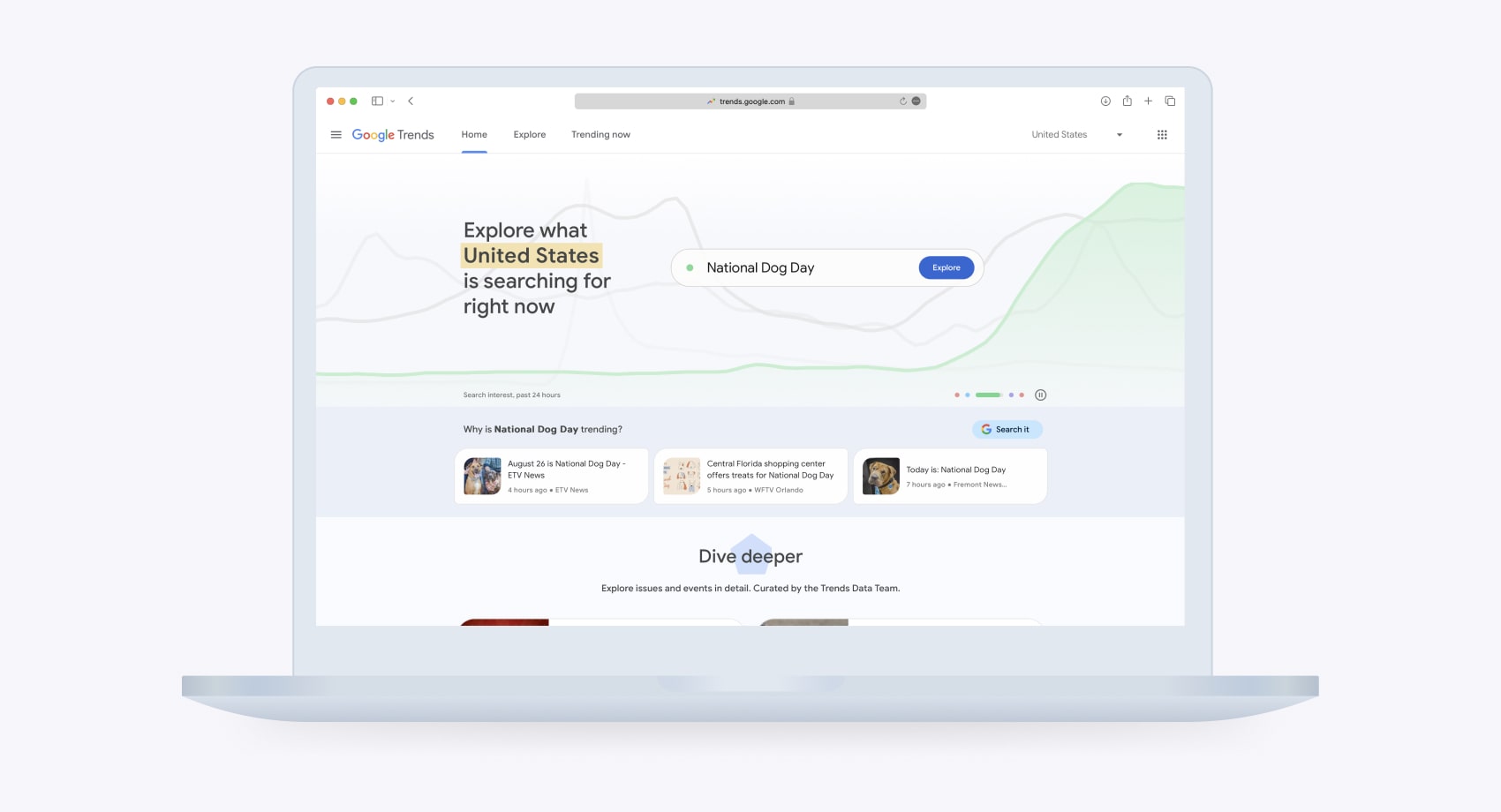
AI tools
Nowadays, AI tools are getting more and more popular in our lives. You can leverage their power to simplify simple tasks. They can do a lot, and you will definitely find an application to both.
- OpenAI's GPT-3 Tools. Being the most popular, GPT-3 is a fantastic tool to generate tables, research simple information and simply ask questions. You can write any prompt you want and the AI model will do its best to respond. Simply put, you can even ask to generate marketing ideas for small businesses!
- Bard by Google. Released not long ago, Bard is a good alternative to GPT-3, offering numerous implementations you can leverage to simplify your daily routine.
Here is a short comparison of both.
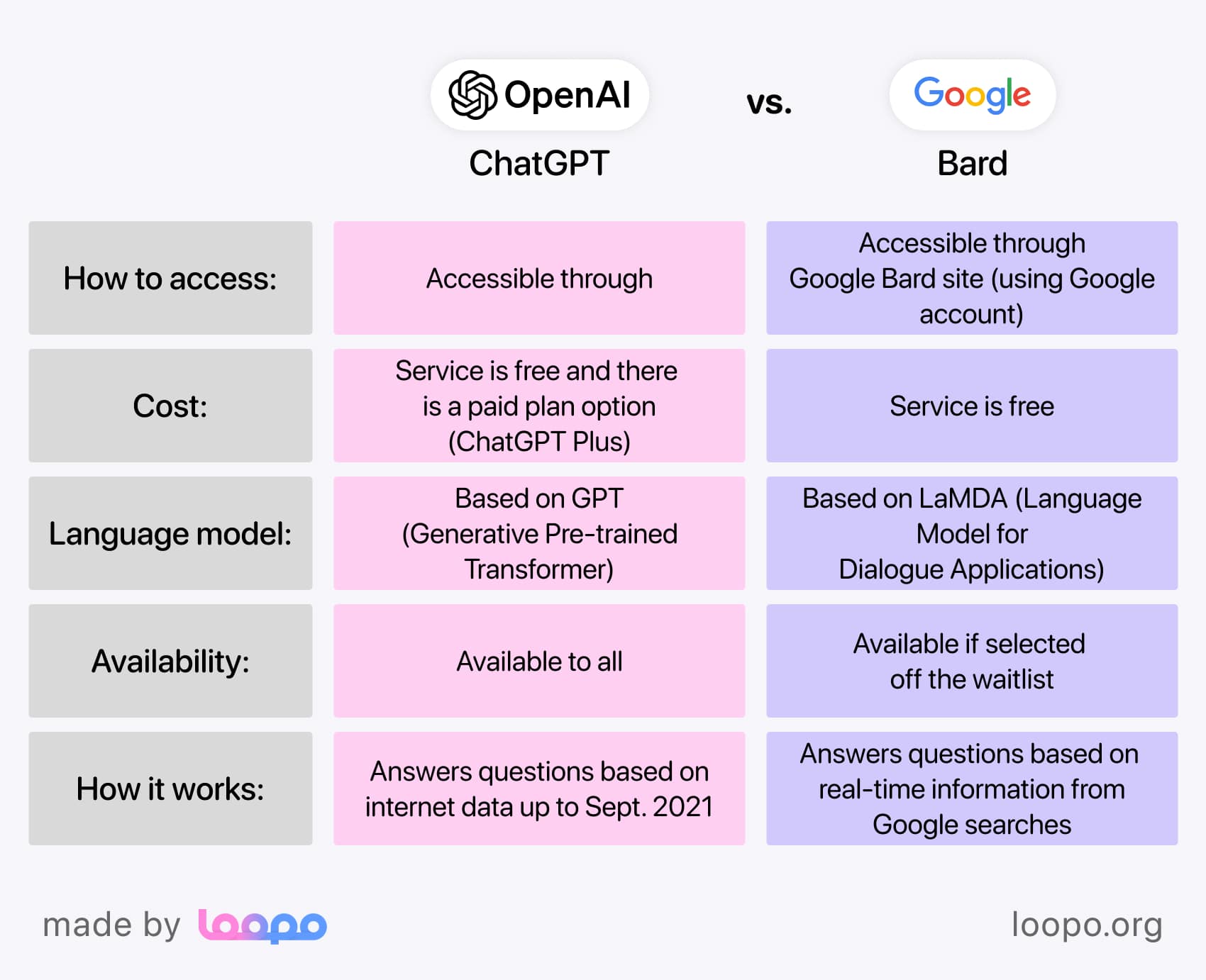
How much does it cost to do content marketing for small business
Calculating a final sum for content marketing costs for a small business requires specific details about the number of content pieces, the frequency of services (e.g., monthly or one-time), and the scope of the project. However, each of the aspects that might be involved in the strategy usually has approximate prices.
Moreover, it’s essential to understand that the cost marketing strategy is rarely evaluated at a full price or one-time payment. The thing is, marketing campaigns can last long and, thus, are better priced on a monthly basis. Moreover, at the very beginning, some part of the total work can be done by the business owner alone. Apparently, you, as the owner, know the best about your business’s values, philosophy, and practices. This way, you will be able to save a lot before you find a solid ground to settle on.
| Content marketing aspect | Minimum monthly cost | Maximum monthly cost | Description |
| Content strategy | $300 | $3,000 | Creating a comprehensive plan outlining goals, target audience, content topics, and distribution channels. |
| Content creation | $400 | $2,000 | Cost for content creation (e.g., blog posts, articles, infographics, videos) depending on complexity and length. |
| Social media management | $300 | $1,500 | Cost for managing social media accounts, including content creation, scheduling, and community engagement. |
| Email marketing | $100 | $500 | Cost for designing and sending newsletters, promotional emails, and automated email campaigns. |
| Search engine optimization | $300 | $2,000 | Cost for optimizing website content, building backlinks, and improving search engine rankings. |
| Graphic design | $50 | $200 | Cost for creating visuals like custom images, infographics, banners, and other graphics for content marketing. |
| Video production | $500 | $5,000 | Cost for creating high-quality promotional or explainer videos, including scripting, shooting, and editing. |
| Content distribution | $100 | $2,000 | Cost for promoting content through paid ads, influencer partnerships, or content syndication platforms. |
| Analytics reporting | $100 | $500 | Cost for tracking performance metrics and generating reports to measure the effectiveness of content marketing. |
| Total monthly cost | $2,150 | $16,700 | Range of total monthly costs for content marketing (sum of all aspects). |
Bottom line
As mentioned earlier, creating a content marketing strategy is neither easy nor difficult. It is rather complex as it includes numerous steps you need to take in order to achieve success. The digital world continues to grow, and marketing ideas for small businesses appear regularly. Hence, it is always important to learn something new, follow trends and new insights.
We sincerely hope this article will be your helpful guide in the world of digital marketing. However, it doesn’t stop here, as we have much more interesting materials about growing a marketing agency, creating a professional team, or organizing it. Feel free to check out our blog, as it can bring a lot of knowledge and marketing ideas for small business you are planning to grow.




